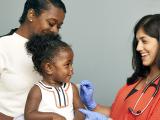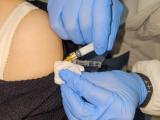May 8, 2002 (CIDRAP News) A bioterrorist attack using hemorrhagic fever viruses (HFVs) such as Ebola would find the healthcare system poorly prepared, with effective drugs few and vaccines nearly nonexistent, according to a report published by an expert panel in today's issue of the Journal of the American Medical Association.
"The diagnostic and therapeutic armamentarium urgently needs to be augmented. There also is an urgent need to develop vaccines and drug therapy," states the report by the 26-member Working Group on Civilian Biodefense. The list of authors is led by Luciana Borio, MD, and Thomas Inglesby, MD, of Johns Hopkins University in Baltimore.
Diagnosis of HFVs would be difficult, and the only available drug treatment is ribavirin, an antiviral that may be effective for some of the viruses but not all, according to the report. Yellow fever is the only HFV for which a proven vaccine exists, and it is in short supply.
HFVs are among the six agents listed by the Centers for Disease Control and Prevention (CDC) as most likely to be used as biological weapons (category A agents). The HFVs include Ebola and Marburg (Filoviridae), Lassa fever and New World arenaviruses (Arenaviridae), Rift Valley fever (Bunyaviridae), and yellow fever, Omsk hemorrhagic fever, and Kyasanur Forest disease (Flaviviridae).
Several studies have shown that nonhuman primates can be infected by aerosol preparations of Ebola, Marburg, Lassa, and New World arenaviruses, the report says. History does not support the argument that the lack of effective drugs and vaccines would keep terrorists from trying to use the viruses, the authors add. They say the Japanese cult Aum Shrinrikyo tried unsuccessfully to obtain Eobla virus.
Nations were more successful, as HFVs were "weaponized" by the United States, the Soviet Union, and Russia, the report says. The Soviet Union and Russia produced Marburg, Ebola, Lassa, and New World arenaviruses until 1992, and the United States produced Yellow fever and Rift Valley fever viruses in its bioweapons program, which was halted in 1969.
People are infected with HFVs by contact with infected animals or animal excretions or from arthropod bites (though the natural reservoirs of Ebola and Marburg viruses are not known). Except for Rift Valley fever and the flavivirus diseases (yellow fever, Omsk hemorrhagic fever, and Kyasanur Forest disease), HFVs spread from person to person by close contact. Airborne transmission also can occur but is rare, the report says.
Clinical manifestations of viral hemorrhagic fevers (VHFs) may include fever, myalgias, rash, and encephalitis, but presentations vary depending on the virus, the authors say. Though some clinical features provide useful clues, it may not be possible to distinguish among the diseases on clinical grounds alone. In the later stages, patients may have signs of "progressive hemorrhagic diathesis," such as petechiae, mucous membrane and conjunctival hemorrage, and hematuria. The fatality rate varies widely, from 0.5% for Omsk hemorrhagic fever to 90% for Ebola (subtype Zaire).
The differential diagnosis for VHFs includes a long list of viral and bacterial diseases and a few noninfectious conditions as well. "The variable clinical presentation of these diseases presents a major diagnostic challenge," the article says. "Clinical microbiology and public health laboratories are not currently equipped to make a rapid diagnosis of any of these viruses, and clinical specimens would need to be sent to the CDC or the US Amry Medical Research Institute of Infectious Diseases" (USAMRIID). The initial diagnosis should be based on clinical criteria, but it should be confirmed by lab testing if possible, the article advises.
"The mainstay of treatment of VHF is supportive, with careful maintenance of fluid and electrolyte balance, circulatory volume, and blood pressure," the report states. The Food and Drug Administration (FDA) has not approved any antiviral drugs for VHFs, but ribavirin, which is used in hepatitis C patients, has some activity against Rift Valley fever and the arenaviruses, though it is not effective for Ebola, Marburg, and the flaviviruses.
For "contained casualty" situations, the working group recommends using intravenous ribavirin for VHFs when the cause is unknown. If mass casualties make intravenous ribavirin treatment impossible, oral ribavirin is recommended. Ribavirin is contraindicated for pregnant women and is not approved for children, but the authors say that for VHF patients the benefits probably outweigh the risks.
The authors do not recommend using ribavirin in asymptomatic people with known or suspected exposure to an HFV. Instead, such people should be monitored and should take their temperature twice daily. If their temperature reaches 101ºF or higher, ribavirin treatment should be started unless VHF is ruled out or the cause is known to be a filovirus or flavivirus.
No licensed vaccine is available for any of the VHFs except yellow fever, the article states. Though the yellow fever vaccine is very effective, "world stocks are not sufficient to meet a surge," and it is not effective for postexposure use because the incubation period of yellow fever is too short.
Given the lack of effective treatments and vaccines, rigorous infection control measures would be the main tool for controlling the spread of VHFs, the authors advise. They rcommend VHF-specific barrier precautions and, because airborne transmission can't be excluded, airborne precautions as well. Also, because some of the viruses can persist in bodily fluids for a long time, they recommend that patients refrain from sexual activity for 3 months after clinical recovery from a filoviral or arenaviral infection.
The report proposes an extensive research agenda for VHFs. Besides the development of drugs and vaccines, "Clarification of the role of airborne transmission is vital," and rapid diagnostic methods need to be developed for all of the viruses, the authors say. Promising vaccines are being tested for some of the diseases, but research is hampered by the need to conduct it in biosafety level 4 laboratories.
Finally, the authors recommend that the supply of ribavirin be rapidly increased and that studies be done to test its effectiveness and safety for selected HFVs and support FDA approval. "We also recommend the addition of intravenous and oral formulations of ribavirin to the US National Pharmaceutical Stockpile," they add.
Borio L, Inglesby T, Peters CJ, et al. Hemorrhagic fever viruses as biological weapons. JAMA 2002;287(18) [Abstract] [Full text]


















